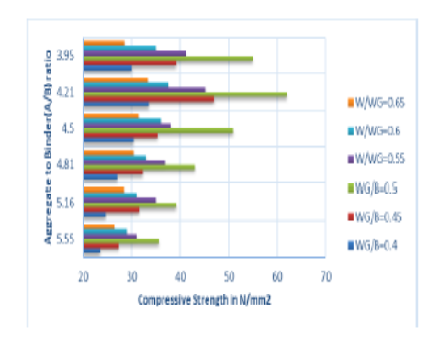


Indian Journal of Science and Technology
DOI: 10.17485/IJST/v16i41.1943
Year: 2023, Volume: 16, Issue: 41, Pages: 3648-3656
Original Article
Rajashekar Sangi1,2*, Bollapragad Shesha Srinivas3, K Shanker4
1Research Scholar, Kakatiya University, India
2Assistant Professor, Kamala Institute of Technology and Science, Telangana, India
3Professor, Kakatiya University, Telangana, India
4Principal, Kamala Institute of Technology &Science, Telangana, India
*Corresponding Author
Email: [email protected]
Received Date:10 August 2023, Accepted Date:16 September 2023, Published Date:07 November 2023
Objectives: To find the mechanical properties of fly ash and GGBS-based Geopolymer concrete (GPC), and to economize GPC production. Methods: Geopolymer concrete was developed by adding equal proportions of Flyash and GGBS as binding materials, to activate the polymerization reaction and to make GPC production an economical, impure form of sodium silicate named “water glass” used as the activator. By varying the water glass-to-binder ratio, Binder content, and total aggregate-to-binder ratio, Concrete specimens of size 100mmx100mm are cast and curing is done at ambient conditions. The compressive strength of GPC was examined under ambient curing, from these data G20 and G30 mix proportions are developed. For these grades of GPC, the optimum dosage of Glass, Steel, and Polypropylene fibers was found. By using the optimum dosage of fibers split tensile, Flexural, and Shear strength properties were examined. Findings: It was identified that Water glass improved the Mechanical properties of GPC, and the addition of fiber steadily increased strength up to some limit after that strength started to diminish. The optimum dosage of steel fiber is 1.5%, Glass 0.8%, and Polypropylene fingers 0.6% respectively. The impact of fibers on shear strength was comparatively moderate when contrasted with their influence on flexural and split tensile strength. Novelty: To activate polymerization reaction, a combination of NaOH and Na2SiO3 are commonly used as activators in GPC, but these are not cost-effective and when GGBS is used as the binder in GPC it will react quickly with these activators. In the Present investigation instead of this activator, Water glass was used as an activator; it economized the GPC production and improved the workability and mechanical properties of GPC.
Keywords: Geopolymer Concrete, Water Glass, Compressive Strength, Glass Fiber, Polypropylene Fiber, Steel Fiber
© 2023 Sangi et al. This is an open-access article distributed under the terms of the Creative Commons Attribution License, which permits unrestricted use, distribution, and reproduction in any medium, provided the original author and source are credited. Published By Indian Society for Education and Environment (iSee)
Subscribe now for latest articles and news.